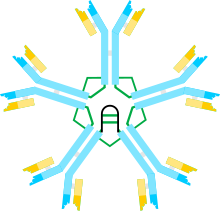
Back غلوبيولين مناعي م Arabic Immunoglobulina M Catalan Imunoglobulin M Czech Immunoglobulin M Danish Immunglobulin M German Ανοσοσφαιρίνη Μ Greek Inmunoglobulina M Spanish M immunoglobulina Basque ایمونوگلوبولین ام Persian Immunoglobuliini M Finnish
| Immunoglobulin M | |||||||
|---|---|---|---|---|---|---|---|
| (pentamer) | |||||||
 | |||||||
| Protein type | antibody | ||||||
| |||||||
Immunoglobulin M (IgM) is the largest of several isotypes of antibodies (also known as immunoglobulin) that are produced by vertebrates. IgM is the first antibody to appear in the response to initial exposure to an antigen;[1][2] causing it to also be called an acute phase antibody. In humans and other mammals that have been studied, plasmablasts in the spleen are the main source of specific IgM production.[3][4]
- ^ "Immunoglobulin M". The American Heritage Dictionary of the English Language (Fourth ed.). Houghton Mifflin Company. 2004. ISBN 978-0618082308.
- ^ Alberts, B.; Johnson, A.; Lewis, J.; Walter, P.; Raff, M.; Roberts, K. (2002). "Chapter 24". Molecular Biology of the Cell (4th ed.). Routledge. ISBN 978-0-8153-3288-6.
- ^ Capolunghi, F.; Rosado, M. M.; Sinibaldi, M.; Aranburu, A.; Carsetti, R. (2013). "Why do we need IgM memory B cells?". Immunology Letters. 152 (2): 114–20. doi:10.1016/j.imlet.2013.04.007. PMID 23660557.
- ^ Williams, N.; O'Connell, P. R. (2008). "Chapter 62". Bailey & Love's Short Practice of Surgery (25th ed.). CRC Press. p. 1102. ISBN 9780340939321.
© MMXXIII Rich X Search. We shall prevail. All rights reserved. Rich X Search